Bàng-uâ-cê or Fuzhou romanization (福州話羅馬字), is a Latin alphabet for the Fuzhou dialect of Eastern Min adopted in the middle of the 19th century by Western missionaries. It had varied at different times, and became standardized in the 1890s. Bàng-uâ-cê was mainly used inside of church circles, and was taught in some mission schools in Fuzhou. However, unlike its counterpart Pe̍h-ōe-jī for Hokkien, even in its prime days Bàng-uâ-cê was by no means universally understood by Christians.
An English-Chinese Dictionary of the Foochow Dialect, 2nd Edition, published in 1905
Dictionary of the Foochow dialect, 3rd Edition, published in 1929
Hand-written note in Bàng-uâ-cê, ca. 1910. It reads: "...You are our dwelling place. Before the mountains were born or you brought forth the earth and the world, from everlasting to everlasting you are God. And we are thankful, because Jesus died for us, resurrected, and enabled us to live in the life full of abundance. He helps us conform to the image of the Lord, and be patient and serve Him with all our heart. He teaches us to willingly forgive people..."
The Fuzhou language, also Foochow, Hokchew, Hok-chiu, or Fuzhounese, is the prestige variety of the Eastern Min branch of Min Chinese spoken mainly in the Mindong region of Eastern Fujian Province. As it is mutually unintelligible to neighbouring varieties in the province, under a technical linguistic definition Fuzhou is a language and not a dialect. Thus, while Fuzhou may be commonly referred to as a 'dialect' by laypersons, this is colloquial usage and not recognised in academic linguistics. Like many other varieties of Chinese, the Fuzhou dialect is dominated by monosyllabic morphemes that carry lexical tones, and has a mainly analytic syntax. While the Eastern Min branch it belongs to is relatively closer to other branches of Min such as Southern Min or Pu-Xian Min than to other Sinitic branches such as Mandarin, Wu Chinese or Hakka, they are still not mutually intelligible.
The authoritative Foochow rime book Qī Lín Bāyīn
Dictionary of the Foochow dialect, 3rd Edition, published in 1929
Japanese-Chinese Translation: Fuzhou Dialect, published in Taipei, 1940. Foochow kana is used to represent Foochow pronunciation.
Pupils in Gulou Experimental Elementary School (鼓樓實驗小學) in Fuzhou are learning the Foochow nursery rhyme Cĭng-cēu-giāng (真鳥囝)






